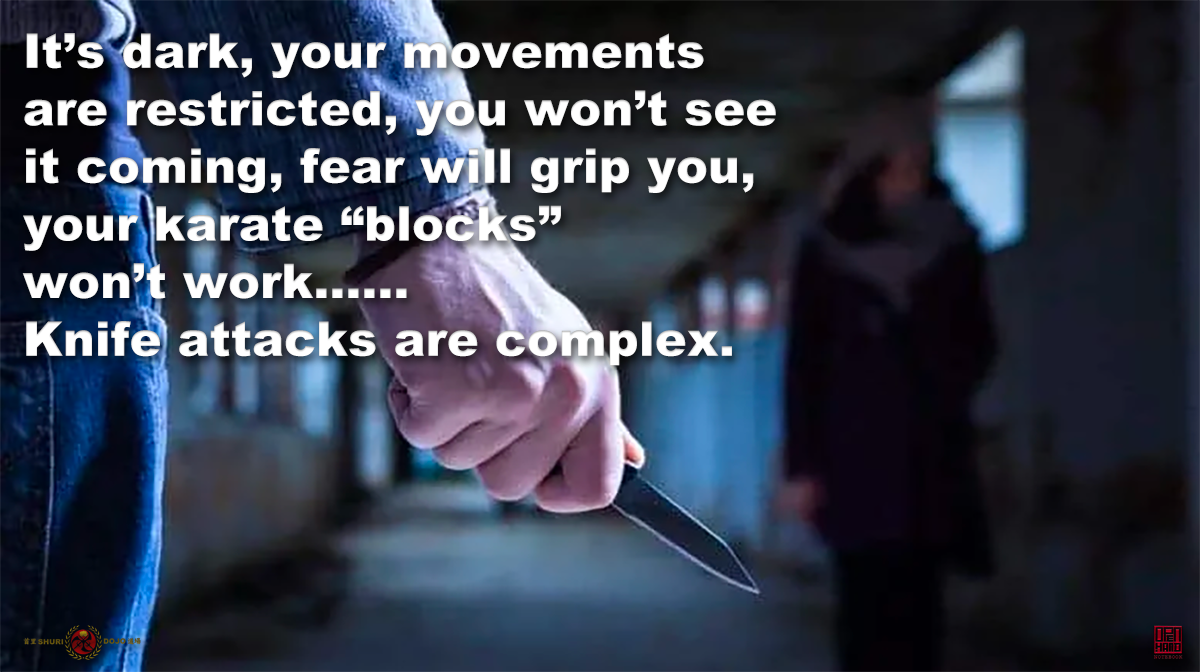
Defense against knife attacks remains one of the most contentious parts of the martial arts. Very few instructors actually have any substantial experience of this type of violence and it’s a very difficult and complex topic.
.
Most of what is taught in martial arts classes is passed on by instructors who have never used any of the techniques they teach in any kind of real-life scenario.
.
In order to adopt realistic methods of defense against knife attacks, you first need to understand how an attacker is most likely going to use his weapon against you.
.
But how do we get that understanding?
.
The truth is, you mostly rely on martial arts instructors (the ‘experts’) to give the answers. But the problem is that these martial arts instructors and schools are plagued by misconceptions and fallacies.
.
Watch any knife defense class in a karate dojo and you will see unrealistic and possibly dangerous techniques being utilized.
.
Firstly, like most violent encounters, whether with or without a weapon, most knife attacks are ambushes, not duels.
.
The bad guys don’t want a fair fight but an easy prey – they’ll make a surprise attack on you from a ‘concealed’ position or with ‘concealed’ intentions….. And you probably won’t see it coming.
.
The knife is kept hidden until the very last moment. That is until the attack is launched. Aggressors will try to distract the victim and wait for a good window of opportunity to strike.
.
The fact that, during a knife attack, aggressors usually lead with their free hand, while keeping the knife close to their side. This is rarely dealt with in your typical martial arts class.
.
Most commonly (over 70% of the time) [1] aggressors will lead the attack with their empty hand, effectively shielding the knife. The empty hand is not a dead hand and attackers will use it to strike or, more commonly, to grab the victim.
.
Knives are short range weapons, so it doesn’t come as a surprise that knife attacks start at conversation range. It’s important to stress that what this really means is; “at arm-length or less”: This leaves you with very little space (and time) to react!
.
Such a small ‘reactionary gap’ means that it’s almost impossible to stop the first stab if you’re not expecting it. Knife attacks are fast and furious and not usually single attacks, more often performed with quick, short, repetitive stabs at different angles.
.
This is an important point because most attacks are not a ‘single straight thrust’, more commonly the “sewing machine” or “prison shanking”, short rapid stabs are very difficult to stop because there is not much time and not much space to ‘deflect-and-redirect’ the attack or ‘block-and-strike’.
.
The more you get cut or stabbed, the more chances a vital organ, such as the heart, or a major artery, such as the carotid artery, will be hit which would result in a quick death.
.
Below are 10 things (there are more) you need to consider.
.
1. You will be taken by surprise and you maybe overwhelmed by fear and aggression
2. You won’t see the blade before the attack is launched
3. You very likely won’t be able to run away and avoid the attack
4. You will have very little time and space to react and deploy a counter-attack
5. You probably won’t be able to stop the first stab(s) so, yes, you WILL be cut or stabbed a number of times
6. You probably won’t have time to draw your own weapon (if you have one); at least not before being stabbed a couple of times
7. You will be likely moving backwards, your balance will be compromised, and you may fall to the ground
8. Your movements will be restricted, your fine motor skills will fail, you won’t able to access the knife bearing arm easily
9. Any technique that is based on arm deflection and manipulation has very little chance to work
10. Any technique that rests on the assumption of a single straight thrust has very little chance of working
.
The real world of knife attacks are that they are vicious, brutal, fast and effective. And really easy to hide until it’s all but too late. You rarely if ever leave a knife attack without an injury. Success is minimizing those injuries, and living through an attack.
.
Don’t be fooled by the so called ‘experts’. Most “knife fighting” training that is currently taught in martial arts classes has very little to do with how knives are commonly used in violent situations. This is because much of what is being taught is dependent on what can only be called ‘dueling’, and the instructor probably has little to no real-life experience.
.
So remember, your possessions can be replaced, your life cannot. ![]()
![]()
.
.
References: (1) Don Pentecost “Put’em down, take’em out! knife fighting from Folsom prison” 1988 – & with thanks to Patrice Bonnafoux
.
.
For those that maybe interested, additionally to my martial arts experience and training, my understanding of this subject comes from first hand knowledge derived from, early in my career, the British Army, the Police service, and before I took early retirement, an EMT for the UK NHS Ambulance Service.
.
